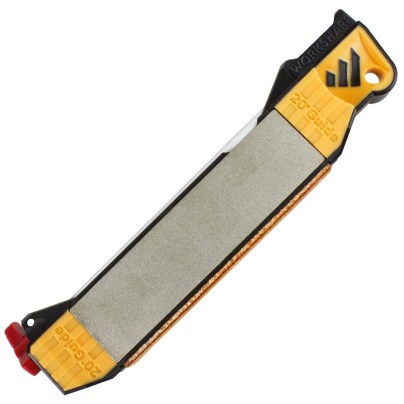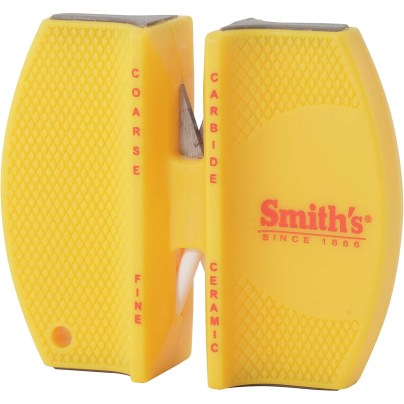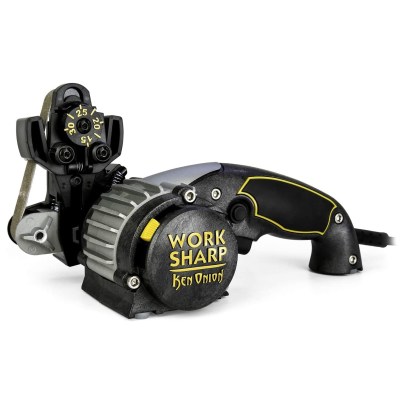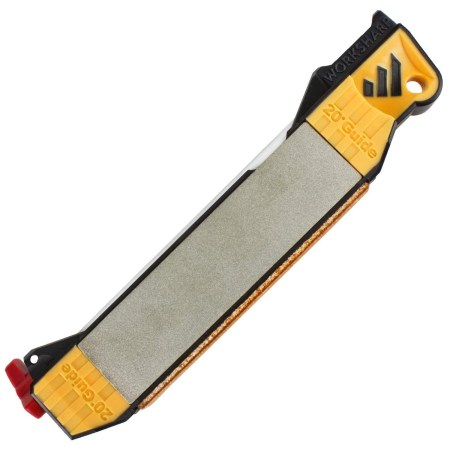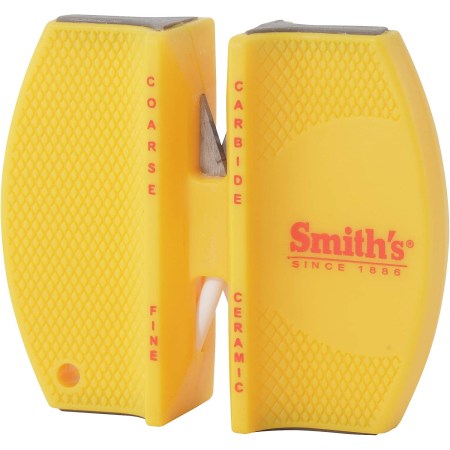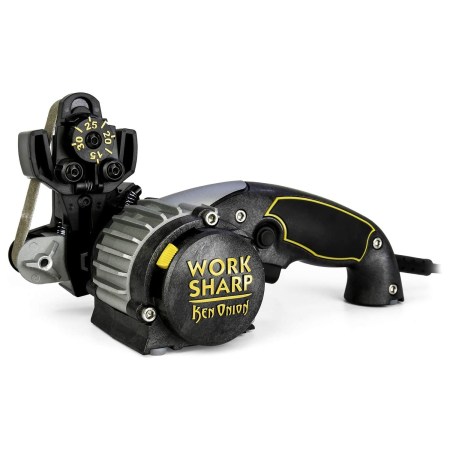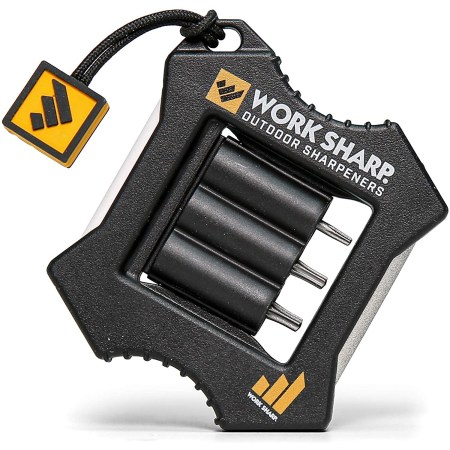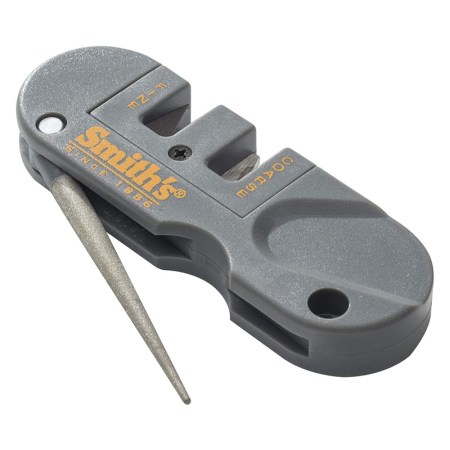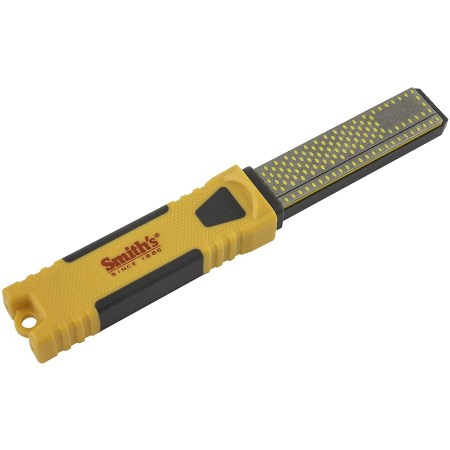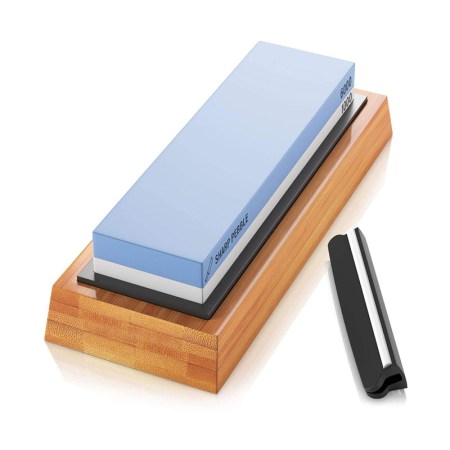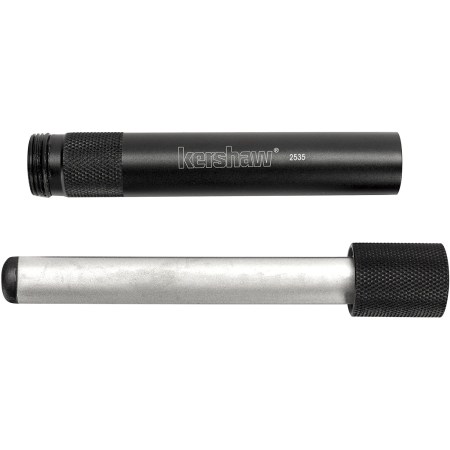We may earn revenue from the products available on this page and participate in affiliate programs. Learn More ›
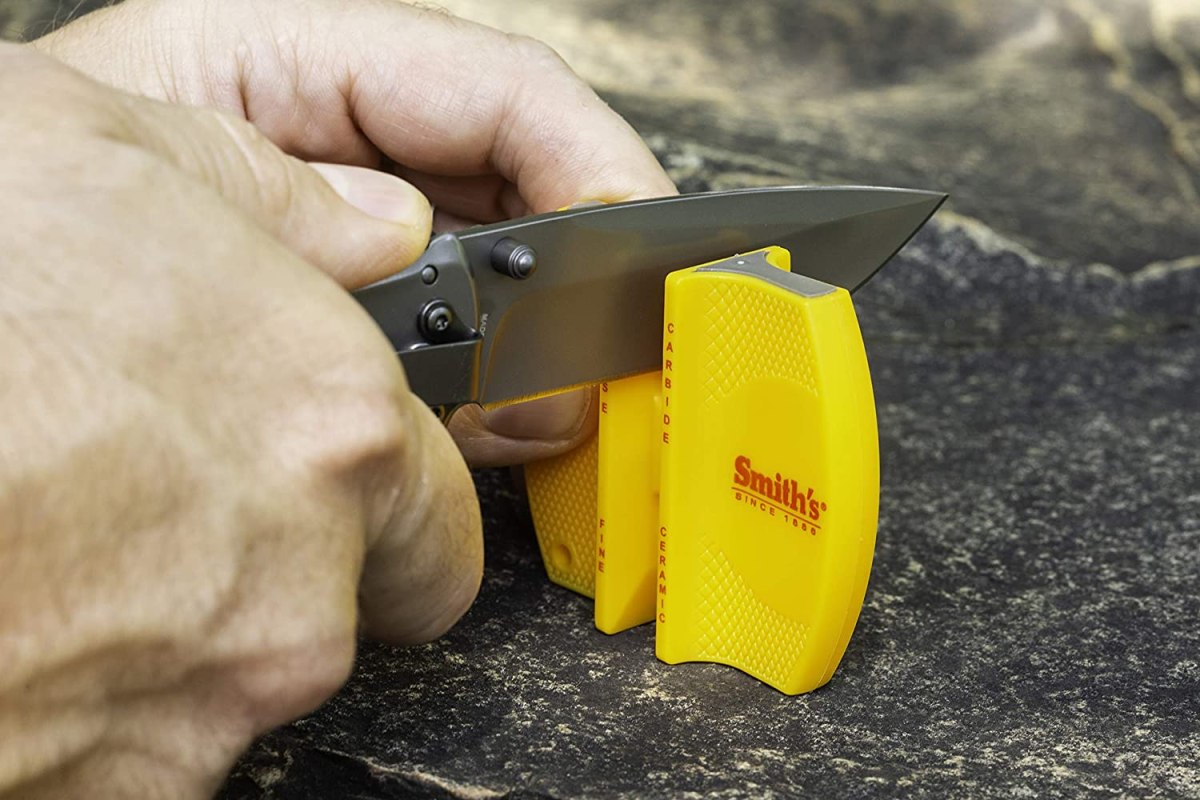
Any professional chef will tell you that a sharp knife is a safe knife—and that goes for your trusty pocket knife as much as any kitchen utensil. Trying to muscle a dull knife through an object is how people get hurt. When you consider a pocket knife’s small grip size, overpowering a blade’s edge can lead to disastrous consequences. We tend to use pocket knives in challenging, relatively dynamic circumstances, like cutting rope, opening packages, or carving a clean tip on a stick for a marshmallow roast; these activities only become more difficult with a dull knife. The best pocket knife sharpeners will keep your blade honed and fresh, making short (and safe) work of a carving or cutting project. Plus, most are small enough to carry in your pocket along with your knife for convenience on the go, while others can easily stow away in a hiking pack.
Pocket knives tend to be very personal to their carrier with some families handing them down from generation to generation, more like family heirlooms than tools. So when it comes to keeping a perfectly honed edge on a prized possession, only the best pocket knife sharpener will do. You’re sure to find yours among the eight sharpeners reviewed here, selected for quality, price, and customer satisfaction.
- BEST OVERALL: Work Sharp Guided Field Sharpener
- BEST BANG FOR THE BUCK: Smith’s CCKS 2-Step Knife Sharpener
- UPGRADE PICK: Work Sharp Knife & Tool Sharpener, Ken Onion Edition
- BEST MULTIUSE SHARPENER: Work Sharp EDC Micro Sharpener & Knife Tool
- BEST POCKET SIZE: Smith’s PP1 Pocket Pal Multifunction Sharpener
- BEST DIAMOND SHARPENER: Smith’s Diamond Combo Bench Stone
- BEST WHETSTONE: Sharp Pebble Premium Whetstone Knife Sharpening Stone
- BEST HONING ROD: Kershaw Ultra-Tek Blade Sharpener
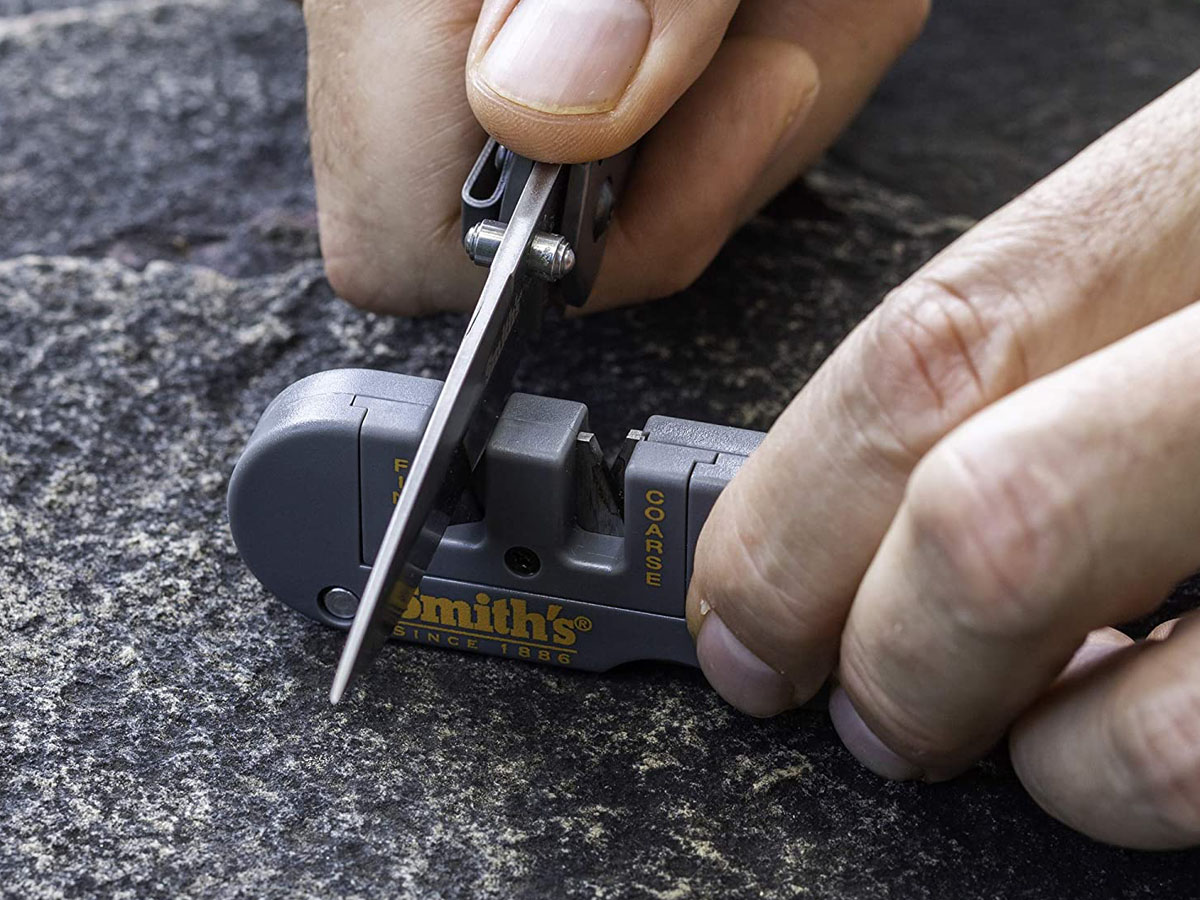
Types of Pocket Knife Sharpeners
Just as there are plenty of different styles of pocket knives, there are a few different types of pocket knife sharpeners available. Each style works a bit differently to put an edge on your blade. Before you decide on the best pocket knife sharpener, familiarize yourself with the different types so you’ll be able to make a great decision.
Sharpening Stone
A sharpening stone is a rectangle-shaped chunk of stone with gritty material embedded in it. You drag the edge of your knife across the stone to remove metal and reshape your blade.
Most sharpening stones today aren’t naturally occurring. The ability to create stones with consistent grit largely did away with the need to mine for sharpening stones. Now manufacturers can create stones in varying grits. The higher the number, the closer the pieces of grit are together, and the finer the edge it can put on your blade.
Sharpening Steel
A sharpening steel is a rod with diamond (or other sharpening bits) embedded in its surface. When you drag your knife blade across a sharpening steel, it will remove metal, allowing you to fix damaged or chipped knife edges. Sharpening steels are great for restoring antique knives, though it can be challenging to get a consistent edge until you have the technique down.
Knife Hone
Opposite of a sharpening steel, knife hones do not remove metal from the edge of your knife. Instead, a knife hone reshapes the metal on the very edge of your knife. Essentially, a hone forces the edge of the knife to a sharp point without removing metal. They’re usually steel in construction, and they can be an ideal final step in your sharpening process.
Electric Sharpener
If you’d prefer a high-tech, high-convenience approach to your pocket knife sharpening, an electric sharpener might be worth considering. These sharpeners use grinding wheels or belts to remove metal quickly, allowing you to take a knife from severely damaged to sharp in short order. Be aware they work very quickly, so you could potentially damage your knife if you’re not paying attention.
What to Consider When Choosing the Best Pocket Knife Sharpener
Before you start shopping for the best pocket knife sharpener for your needs, there are some things you should know. The following section outlines all of the important details that you should look out for while you’re shopping for your new sharpener. Keeping these considerations in mind will help ensure you choose a great model.
Size and Weight
Choosing the best pocket knife sharpener for your needs could come down to size and weight. After all, a sharpener is a tool, and if it’s too unwieldy to handle, your sharpening could become unsafe.
Also, consider storage. A professional set of sharpening stones can be pretty heavy and could be difficult to store away. Conversely, a sharpening rod weighs less than a pound and will usually stash away quite nicely in a knife block or drawer. Compact isn’t always everything, however. A smaller sharpener requires a firm grip to be safe, so keep that in mind before you purchase the smallest sharpener you can find.
Adjustable Angle
When it comes to sharpening your pocket knife, most tools require you to determine the angle you’ll be using to grind a new edge on your blade. By changing the pitch of the grind, you can change how sharp your knife will be. Some tools have adjustable angles or at least guides that you can follow to choose between grind angles.
It’s worth pointing out that, generally speaking, sharp and durable have an inverse relationship when it comes to cutlery. The sharper the knife’s grind, the harder it will be to maintain. The more durable the knife’s edge, the duller it will be. You need to find a happy medium for each blade, but 17 degrees is a great starting point.
Sharpening Stages
Sharpening your pocket knife to the ideal edge is a process. You’ll usually have to start with a more aggressive grit number (the lower the number, the more aggressive) and progressively work your way to a finer grit.
Many sharpeners come with some form of staging when sharpening. Some have built-in diamond sharpeners as well as ceramic honers. The idea is that you’ll need to remove the bulk of the material with an aggressive grit, then fine-tune it with a finer grit. Be sure that you choose a sharpener that allows you to work up to your desired edge.
Abrasive Surface
When you’re on the hunt for your new pocket knife sharpener, you’ll want to give the types of sharpening abrasives available some thought.
When it comes to artificial stones, you’ll find a variety of abrasive grits added through the stone. Abrasives like diamonds, tungsten carbide, and aluminum oxide are popular additions to these stones, and they do an excellent job of removing metal and polishing it to a finer edge. Ceramic also does a fine job as the last step before honing. There are also natural stones, but they create less consistent results.
Steel honing rods will allow you to maintain your edge without grinding nearly as often, so it’s a good idea to have one on hand to extend the life of your blade.
Versatility
Pocket knives themselves are all about versatility, so it should make sense that you’d look for a bit of extra versatility from your knife sharpener. Many knife sharpeners can handle different styles of blades, so it’s worth checking into before you make a purchase.
As an example of versatility, you can find sharpeners to handle pocket knives, kitchen knives, and scissors. Also, some sharpeners do a better job than others at sharpening serrated blades, so be sure to check any prospective sharpener for this ability if that matters to you.
Safety
Anytime you’re attempting to make a tool sharper, there is a risk of injury that you need to keep in mind. You can cut yourself if you aren’t careful.
Many sharpeners help to mitigate the danger involved in sharpening. Some tools come with cut-resistant gloves you can wear to prevent from cutting yourself. Others include built-in finger guards to keep your digits clear of the blade.
Regardless of the type of sharpener and the types of built-in safety features it has, you need to be careful when working with sharp knives, scissors, and blades of any kind.
Our Top Picks
If you like maintaining a perfect edge (also known as grind), this guide will help you choose the best pocket knife sharpener. From basic pull-through sharpeners to versatile high-tech models, these top picks will guide you to the best pocket knife sharpener for you.
Best Overall
Work Sharp Guided Field Sharpener
See ItWith several sharpening and honing surfaces, including diamond-coated plates, ceramic honing rods, and a leather strop, plus guides for maintaining the perfect angle, the Work Sharp Guided Field Sharpener is truly the one of the best pocket knife sharpeners on the market. The built-in guides help you dial in either a 20- or 25-degree angle, and the multiple sharpening surfaces allow you to work your way from a dull, damaged blade to a precision tool with a surgically sharp edge. It’s a full-service sharpening system that will put a razor-sharp edge on any pocket knife, but it is a bit bulky.
It’s unlikely that you’ll be comfortable taking this in the field with you, unless you tote it in a backpack.
Best Bang for the Buck
Smith's CCKS 2-Step Knife Sharpener
See ItThe CCKS 2-Step Knife Sharpener from Smith’s is a handy pocket sharpener useful for putting a quick edge on a knife. This sharpener features a set of carbide blades for grinding a blade smooth, while the set of ceramic rods hone the fine wire-edge left behind during grinding. Simply pull your blade through the carbide side a few times, then finish by cleaning up the edge with the ceramic rods. While it won’t give you a surgical edge, it’s perfect to get you through a tough situation, like cutting off a piece of clothing in a first aid crisis. Plus, it’s perfect for hunters and hikers because its bright yellow finish makes it easy to find if it drops to a forest floor.
Upgrade Pick
Work Sharp Knife u0026 Tool Sharpener, Ken Onion Edition
See ItUpgrade your sharpening game with this top-notch tool. Instead of the grinding wheels other power sharpeners typically use, this sharpener uses a flexible belt to put a sharp and durable edge on your pocket knife. It has variable speeds and blade guides adjustable from 15 to 30 degrees to make dialing in the perfect edge a breeze. Excellent on pocket knives, this sharpener can also handle axes, mower blades, and shovels. Persnickety sharpening aficionados will point out that if you use this tool according to the instructions, you’ll sharpen the left side of your blade in the wrong direction because the belt only spins in one direction. While this tool does create a sharp edge, it technically doesn’t follow conventional sharpening rules.
Best Multiuse Sharpener
Work Sharp EDC Micro Sharpener u0026 Knife Tool
See ItBlade sharpness is one thing, but if the blade or handle of your knife wobbles in your hand, it’s not safe to use. Fortunately, the EDC Micro Sharpener and Knife Tool has everything you need to keep your knife in tip-top shape. It boasts two honing rods (one diamond, one ceramic) with blade angle guides, three standard Torx bits, and a built-in bit driver, so you can tighten up your knife and its edge in no time with one tool. It’s small enough to keep in your pocket, but it also comes with a lanyard for clipping to a backpack or fishing vest.
Best Pocket Size
Smith's PP1 Pocket Pal Multifunction Sharpener
See ItPint-size yet multipurpose, the PP1 Pocket Pal from Smith’s features standard carbide and ceramic blade sets and also has a built-in, folding, diamond-coated rod for honing a perfect edge. The rod’s round shape makes it useful for cleaning up the edge of serrated blades as well. If you don’t want to carry it in your pocket, it has a lanyard hole for strapping to a backpack. Just be aware that the PP1’s tiny size makes it less stable during sharpening than larger sharpeners, so extra care needs to be taken for safe use.
Best Diamond Sharpener
Smith's Diamond Combo Bench Stone
See ItNever find yourself with an inconveniently dull blade again. This Diamond Combo Bench Stone puts a sharp edge on your pocket knife with just a few passes, thanks to a coarse stone for reshaping your blade’s grind and a fine stone for honing its edge. The interrupted diamond surface allows for metal filings to temporarily collect inside the cutouts, allowing you to sharpen your blade quickly without clogging the surface. Also, the stones store inside the handle, making this a compact tool for camping and fishing trips. This bench stone may work very well for smaller pocket knives, but larger trapping-style knives might be a challenge to sharpen, since due to the relatively short length of the stone, you’d run out of stone before you could drag the entire knife edge across the surface.
Best Whetstone
Sharp Pebble Premium Whetstone Knife Sharpening Stone
See ItIf you’re a collector, or you simply prefer to ensure your knife is sharp before you head out, this premium whetstone from Sharp Pebble is ideal. The whetstone kit comes with two grits, 600 and 1000, on opposing sides of the stone. And there’s an included blade guide to help you put an accurate edge on your knife time after time. The nonslip bamboo case functions as a stand, and it’s attractive enough to accompany knives on display. You’ll even get an e-book taking you through the “finer points” of knife sharpening. While this whetstone is useful and versatile (it’s good for kitchen knives, too), it doesn’t work quite as well for the serrated sections of some pocket knives.
Best Honing Rod
Kershaw Ultra-Tek Blade Sharpener
See ItThis Ultra-Tek Blade Sharpener is a nice addition to many kits. The honing rod features a 600-grit, diamond-coated blade that stores away inside of the aluminum body of the sharpener to ensure rod longevity. The oval shape makes it helpful for dialing in blades of all shapes and sizes, especially pocket knives with serrated edges. The knurled design provides plenty of grip when honing your knife while also offering a shoulder to keep your fingers away from the blade. But like all honing rods, it cannot grind your blade down to a perfect edge—you need carbide and ceramic blades for that—so it won’t do much for severely dull blades.
FAQs About Pocket Knife Sharpeners
Even though you’re a bit more seasoned on the types of sharpeners available and which one could work the best for your needs, you might still have some questions. Below is a list of the most commonly asked questions about knife sharpeners, how they work, and what they do. If you still have questions, be sure to reach out to your sharpener’s manufacturer and speak with a customer service representative.
Q. How long does it take to sharpen a pocket knife?
It largely depends on how dull the blade is. You can put a quick edge on a blade that’s already in decent shape in 30 seconds. Other knives might need more work, but rarely will it take more than 10 to 15 minutes once you set your tools up.
Q. Can you ruin a knife by sharpening it?
Absolutely. You can remove too much material and completely reshape the blade to the point that it doesn’t work as well. This is especially important to watch for when sharpening vintage or classic knives.
Q. Should I sharpen a new knife?
Many new knives are sharp, but not as sharp as they could be. They often come out of the package with a bent wire edge on the grind. A honing rod could help create a sharper edge without actually grinding any material away.
Q. How often should you sharpen a pocket knife?
When the blade stops cutting well, you should sharpen it. It depends on how often you use your knife, the blade’s material, and the angle of the grind. A dull knife can be very dangerous to use, as it can become hard to control while still being sharp enough to cut your skin, so make sure to keep your knife nicely honed.
Q. What angle do you use to sharpen a knife?
The best do-all angle for a pocket knife is about 17 degrees. This angle creates a reasonably sharp and durable edge.
Q. Does a sharpening steel wear out?
While it’s rare that you could completely wear out a sharpening steel, the diamonds can start to lose their effectiveness after many, many sharpenings.
